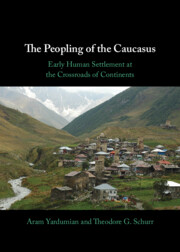481 results

The Shang Economy
-
- Published online:
- 27 March 2025
- Print publication:
- 10 April 2025
-
- Element
-
- You have access
- HTML
- Export citation

Archaeological Wood and Woodworking
-
- Published online:
- 14 March 2025
- Print publication:
- 10 April 2025
-
- Element
-
- You have access
- HTML
- Export citation

Against Moab
- Interrogating the Archaeology of Iron Age Jordan
-
- Published online:
- 14 March 2025
- Print publication:
- 10 April 2025
-
- Element
-
- You have access
- Open access
- HTML
- Export citation
Chapter Nine - A Synthetic View of the Peopling of the Caucasus
-
- Book:
- The Peopling of the Caucasus
- Published online:
- 21 January 2025
- Print publication:
- 23 January 2025, pp 202-208
-
- Chapter
- Export citation
Chapter Ten - Further Research into the Peopling of the Caucasus
-
- Book:
- The Peopling of the Caucasus
- Published online:
- 21 January 2025
- Print publication:
- 23 January 2025, pp 209-216
-
- Chapter
- Export citation

The Peopling of the Caucasus
- Early Human Settlement at the Crossroads of Continents
-
- Published online:
- 21 January 2025
- Print publication:
- 23 January 2025
The cosmopolitanism of Karakorum, capital of the Mongol empire in Mongolia
-
- Journal:
- Modern Asian Studies , First View
- Published online by Cambridge University Press:
- 17 January 2025, pp. 1-28
-
- Article
-
- You have access
- Open access
- HTML
- Export citation
“Bringing ‘The Magic Carpet Up to Date’: Imperial Airways in Iraq, 1920–1932”
-
- Journal:
- Itinerario / Volume 48 / Issue 3 / December 2024
- Published online by Cambridge University Press:
- 14 January 2025, pp. 315-331
-
- Article
-
- You have access
- Open access
- HTML
- Export citation
‘Palestine is our working condition’: border pedagogy, materiality, and the corporate university
-
- Journal:
- Archaeological Dialogues , First View
- Published online by Cambridge University Press:
- 13 January 2025, pp. 1-8
-
- Article
-
- You have access
- Open access
- HTML
- Export citation
16 - Pre-Columbian and Early Historic Native American Warfare
-
-
- Book:
- The Cambridge History of Strategy
- Published online:
- 06 January 2025
- Print publication:
- 09 January 2025, pp 334-345
-
- Chapter
- Export citation
Conclusion
-
- Book:
- Embodied Experience in British and French Literature, 1778–1814
- Published online:
- 19 December 2024
- Print publication:
- 02 January 2025, pp 250-254
-
- Chapter
-
- You have access
- Open access
- HTML
- Export citation
Braiding archaeology, geomorphology and indigenous knowledge to improve the understanding of local-scale coastal change
-
- Journal:
- Cambridge Prisms: Coastal Futures / Volume 3 / 2025
- Published online by Cambridge University Press:
- 20 December 2024, e2
-
- Article
-
- You have access
- Open access
- HTML
- Export citation

The Origins of Agriculture in the Bronze Age Indus Civilization
-
- Published online:
- 13 December 2024
- Print publication:
- 02 January 2025
The Prakhon Chai Hoard Debunked: Unravelling Six Decades of Myth, Misdirection, and Misidentification
-
- Journal:
- International Journal of Cultural Property / Volume 31 / Issue 2 / May 2024
- Published online by Cambridge University Press:
- 12 December 2024, pp. 177-201
-
- Article
-
- You have access
- Open access
- HTML
- Export citation
The tesselle Project: A Collection of R Packages for Research and Teaching in Archaeology
-
- Journal:
- Advances in Archaeological Practice , First View
- Published online by Cambridge University Press:
- 09 December 2024, pp. 1-7
-
- Article
-
- You have access
- Open access
- HTML
- Export citation
Introduction
-
- Book:
- Merovingian Worlds
- Published online:
- 22 November 2024
- Print publication:
- 05 December 2024, pp 1-28
-
- Chapter
-
- You have access
- HTML
- Export citation
Chapter 13 - “Reconsidering Questions of Principle”: Collingwood and the Revival of Celtic Art
- from Part II - Issues in Collingwood’s Philosophy
-
-
- Book:
- Interpreting R. G. Collingwood
- Published online:
- 22 November 2024
- Print publication:
- 05 December 2024, pp 246-261
-
- Chapter
- Export citation
Under the shadow of occupation: cultural, archaeological, and military activities at Topkapı Palace during the armistice period, 1918–1923
-
- Journal:
- New Perspectives on Turkey / Volume 71 / November 2024
- Published online by Cambridge University Press:
- 04 December 2024, pp. 83-113
-
- Article
-
- You have access
- Open access
- HTML
- Export citation

Archaeological Studies on Gender in Early East Asia
-
- Published online:
- 03 December 2024
- Print publication:
- 30 January 2025
-
- Element
- Export citation

Identity Studies in Archaeology
-
- Published online:
- 02 December 2024
- Print publication:
- 02 January 2025
-
- Element
- Export citation

